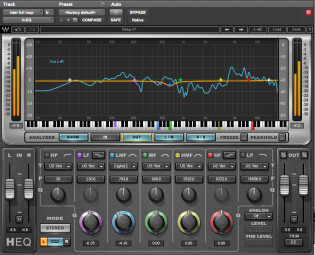In this installment, we'll do a quick review on how to deal with the rest of the mid frequencies and the high end. Why a "quick" review? Well, because there are no systematic rules this time around and, especially, because we can make better use of these frequency bands in the second EQing stage, later on.
The middle lands
Unlike the lows and low/mids, the frequencies between 500 Hz and 6 kHz don’t need to be trimmed down for every instrument. So you’ll have to go track by track to see which ones really need it. Here’s a brief guide to know which frequency ranges to focus on, depending on the symptoms detected:
- If an instrument sounds too shrill, try to scoop out frequencies between 500 Hz and 1 kHz.
- If a track seems to lack thickness, addressing the frequencies between 1 kHz and 2 kHz might help. Generally speaking, taking off 1 dB or 2 dB is more than enough.
- An instrument that has too much presence, according to your vision of the mix, can be trimmed somewhere between 4 kHz and 6 kHz.
- Finally, if the vocals have trouble been heard above some instruments, instead of EQing the vocal track directly, it’s often wiser to attenuate the instruments that are competing with it in the frequency range between 2 kHz and 4 kHz. Why attenuate the other tracks rather than increase this frequency zone directly on the vocals? Well, first of all, because that way you won’t mess with your precious headroom. And, second, boosting frequencies between 2 kHz and 4 kHz too much will tend to fatigue the listener, which is obviously not desirable.
I know I’m repeating myself, but remember you shouldn’t go about it in a systematic way: Why fix it if it ain’t broken?
High profile
Regarding the high frequencies, between 6 kHz and 20 kHz, I recommend not touching them for the time being, since the situation is pretty delicate at this stage. The most daring among you can amuse yourselves attenuating the vocals between 6 kHz and 8 kHz in a very targeted fashion, meaning with a very narrow bandwidth (high Q), in order to reduce invasive sibilants. However, a dedicated processor (De-Esser) will often give you better results.
You can also placate an instrument that is too brilliant by focusing on the 8 kHz to 16 kHz range. Finally, if you want to reign in a sound that’s too airy, a shelving filter beyond 16 kHz ought to do the task. But be careful not to go to hard on it or you risk EQing the life out of the sound.
And what about giving it all a boost?
Don’t worry, we’ll get there! However, I invite you to give a good listen to the mix after this trimming session. Compared to the result from the rough mix, you should notice that things are starting to take shape. Little by little, the different elements start to find their natural place in the sonic puzzle. For example, the guitar you thought was a bit dull should now be much less present, the vocals should now feel much more comfortable, etc. And all that without boosting anything! That’s a good thing, because boosting in certain frequency zones can make a mix sound unpleasant and fatiguing.
The forthcoming episode will be dedicated to the next logical step in EQing: How to remedy the masking phenomenon.

